|
First published: November 3, 2006
Last updated: October 27, 2024
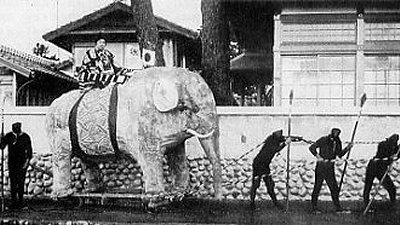 Onisaburo on papier-mache elephant pulled by local children disguised as Indians at the foot of Mount Daisen in Hiezu Village, Tottori Prefecture (Taisho 12, or 1923)
This is where Onisaburo dictated Volumes 57 through 60 to his scribes during his stay at Hamaya Hot Springs Inn.
Table of Contents
- The kata (model)-based correlation between India and Japan
- Who is the Oh Kuro Nushi (Great Black Master)?
- Over a Third of the Monogatari's Volumes Are Set in India
- The Three Major Religions in the Monogatari
- Important events in the Monogatari that describe major confrontations between the Great Kami Kamususanowo and the Great Black Master
The kata (model)-based correlation between India and Japan
The religious group Omoto (literally "Great Source" or "Great Origin") was a divine theatrical troupe that implemented the Kami's programs based on the concept of kata, or models. For details on the kata principles, see The Dragon-Shaped Japanese Islands.
Webmaster's note: The Kami here is interchangeable with the One, God, the Providence, the Supreme Being and the like.)
Omoto's teachings maintain that Omoto serves as a model of Japan, which in turn serves as a model of the world. In other words, what happens to Omoto will happen to Japan in a similar manner, and what happens to Japan will happen to the rest of the world on a larger, more dramatic scale.
Webmaster's note: Onisaburo further says that the solar system is a microcosm of the great universe, that the Earth is a microcosm of the solar system, that the Japanese archipelago is a microcosm of the Earth, and that the Amami islands (part of the Ryukyu islands) is a microcosm of the apanese archipelago.
With Onisaburo as head of the divine theatrical company, Omoto believers often unknowingly sowed seeds (i.e. models) through their actions in the hope that those seeds would grow to let divine power shine through the world to eliminate social evils and corrupt institutions.
Just like any drama, Omoto's divine drama also required villains. Some of those villains were Omoto believers with ulterior motives while others were members of the Deguchi family. The Omoto Shin'yu, a holy text of Omoto, indicates that the Kami often needs to make some members of the Deguchi family play villains because He cannot let other non-Deguchi believers play such roles.
Taka-hime, a character appearing in the Reikai Monogatari, is a case in point. One of the real-life models of Taka-hime is known to be Hisa Fukushima, the third daughter of Nao Deguchi, one of the Omoto founders. Possessed by the evil spirit Yamata no Orochi (Eight-Forked Serpent), Hisa rebelled against Onisaburo with a vengiance by founding her own religious group. She played the role of evil force in Omoto's divine drama, and the seed of her being brought to her knees was planted so that evil force would be beaten into submission in real life going forward. When Hisa passed away, Onisaburo complimented her on playing the role no one else could, thereby contributing to the divine work.
 Hisa Fukushima
Omoto underwent two unlawful government-sponsored persecutions: The First Omoto Incident of 1921, and the Second Omoto Incident of 1935. The Second Omoto Incident in particular is believed to have served as a model of the downfall of the Imperial Japanese Empire.
Basically, there are two types of kata: geographical kata, and provincial-soul kata.
Geographical kata are models based on geographical locations. Provincial-soul kata are models based on the tutelary deities of local provinces.
For example, the Omaezaki Peninsula corresponds to India from a geographical-kata perspective, with the Fuji Mountains, the Fuji River, and the Tenryu River also corresponding to the Himalayas, the Ganges River, and the Indus River, respectively. (See below for details)
The Omaezaki Peninsula = India
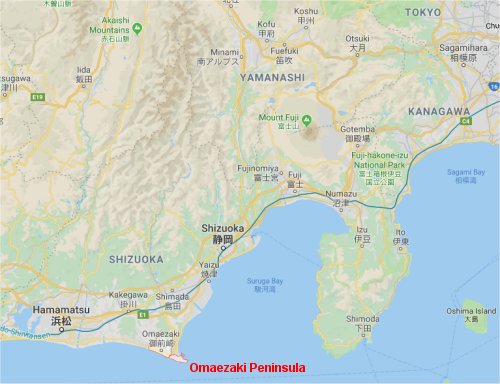 Omaezaki Peninsula
 India
The Fuji Mountains = the Himalayas
 Fuji Mountains
 Himalayas
The Fuji River = the Ganges River
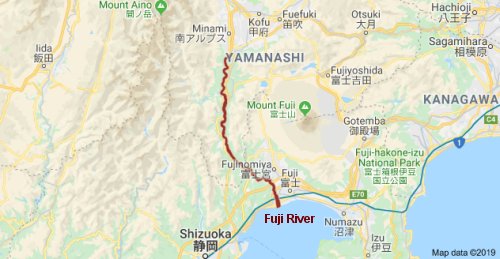 Fuji River
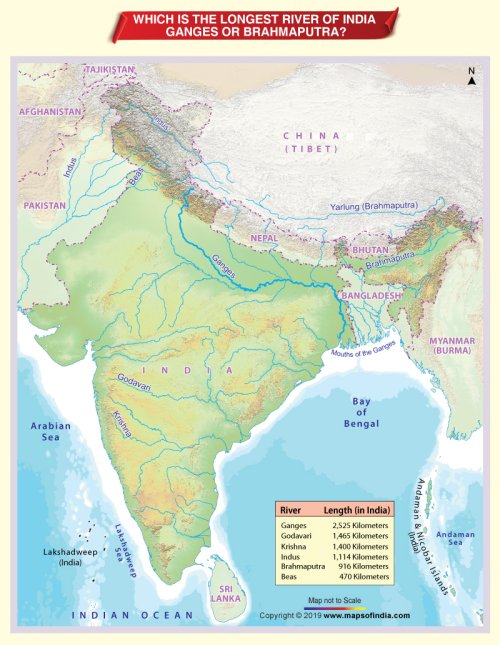 Ganges River Image by courtesy of Maps of India.com
The Tenryu River = the Indus River
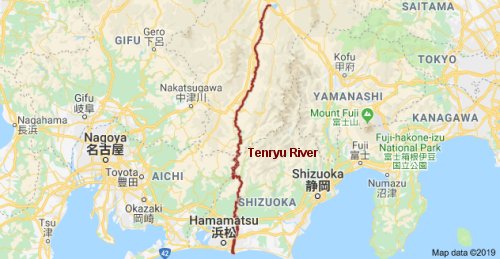 Tenryu River
 Indus River Image by courtesy of The Better India
From a provincial-soul-kata perspective, however, the Indus River corresponds to the Tone River in the greater Tokyo area.
| Type of Kata |
Japanese River |
Corresponding Indian River |
| Geographical Kata |
Tenryu River in
central Japan |
Indus River |
| Provincial-Soul Kata |
Tone River in
eastern Japan |
Indus River |
For that matter, kata models are flexible and can vary depending on circumstances. The following is a list of place names in the Reikai Monogatari and their corresponding place names in real life, as indicated by Onisaburo.
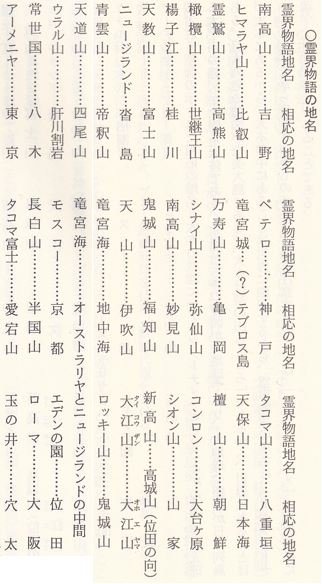 Place names in Monogatari and their corresponding place names in real life. (See below for the translation)
| Place name in Monogatari |
Corresponding place name in Japan |
| Mount Nankoh |
Yoshino area |
| Himalayas |
Mount Hiei |
| Mount Ryoshu |
Mount Takakuma |
| Mount of Olives |
Mount Yotsuoh |
| Yangtze Rive |
Katsura River |
| Mount Tenkyoh |
Mount Fuji |
| New Zealand |
Kutsu Island |
| Mount Seiun |
Mount Taishaku |
| Peter |
Kobe |
| Ryugu Castle |
Tilos Island (?) |
| Mount Manju |
Kameoka area |
| Mount Sinai |
Mount Misen |
| Mount Nankoh |
Mount Myohken |
| Mount Kijoh |
Fukuchiyama area |
| Tian Shan |
Mount Ibuki |
| Ryugu Sea |
Mediterranean Sea |
| Mount Tocoma |
Yaegaki area |
| Mount Tempoh |
Sea of Japan |
| Danzan |
Korea |
| Kunlun Mountains |
Mount Ohdaigahara |
| Mount Zion |
Yamaga area |
| Mount Nihtaka |
Mount Takashiro (in Ida, Ayabe) |
| Mount Taikoh |
Mount Oh-e |
| Mount Kijioh |
Rocky Mountains |
| Mount Tendoh |
Mount Yotsuoh |
| Ural Mountains |
Kimokawa area |
Tokoyo no Kuni
(Land of Eternity) |
Yagi area |
| Armenia |
Tokyo |
| Ryugu Sea |
Sea between Australia and New Zealand |
| Moscow |
Kyoto |
| Mount Choh-haku |
Mount Hangoku |
| Tacoma Fuji |
Mount Atago |
| Garden of Eden |
Ida, Ayabe |
| Rome |
Osaka |
| Tamanoi |
Anao |
Onisaburo goes on to say that the Reikai Monogatari writes about nothing but Japan. His statement is in line with the notion that Japan is a miniature model of the world.
Kunitokotachi no Mikoto (see picture below), the creator of the Earth's divine world, and his wife-deity Toyokumonu no Mikoto were banished by evil deities to three different places, depending on three different levels of kata models:
| Level of kata model |
Kunitokotachi no Mikoto was banished to |
Toyokumonu no Mikoto was banished to |
| Kata of the World |
Japanese Archipelago |
Italian Island of Sardinia |
| Kata of Japan |
Mount Ashibetsu in Hokkaido |
Kikaija Island in Kagoshima |
| Kata of Omoto |
Meshima Island on the Sea of Japan |
Kamijima Island on the Seto Inland Sea |
During his weeklong initiatory experience in the Spirit World, Onisaburo witnessed the "Great Divine Drama of the Whole Wolrd," the Kami's grand design for remodeling the world, along with a wide variety of actors who would play roles in the divine drama at Omoto and elsewhere. (See excerpts below)
Since the Spirit World transcends time and space, past, present and future events appear all at once as if they were reflected in a mirror. Those future events may materialize in the present world in a few days, 10 years or even hundreds of years, depending on circumstances.
In fact, Onisaburo recalled that he met some people he had met late in the Spirit World sooner than other peole he had met early.
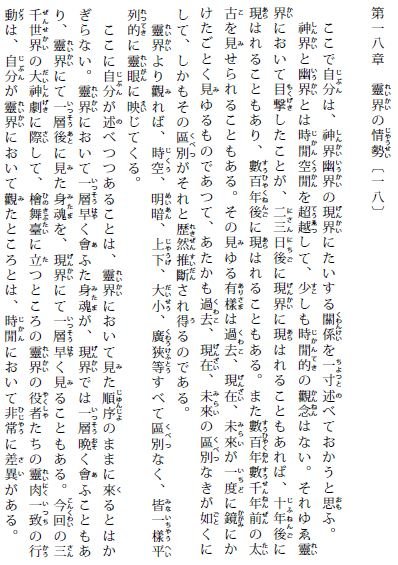 Volume 1, Chapter 18 of the Monogatari (dictated on October 20, 1921) Onisaburo says that the Spirit World transcends time and space, and that past, present and future events appear all at once as if they were reflected in a mirror.
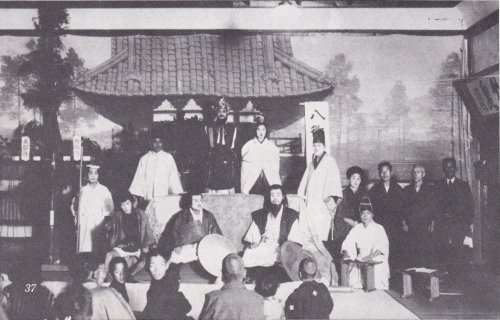 Omoto often played Monogatari-based divine dramas on the stage to promote the religious group's holy scripture.
Who is the Oh Kuro Nushi (Great Black Master)?
Onisaburo's Reikai Monogatari describes the Oh Kuro Nushi (Great Black Master) as head of the Brahman faith with its headquarters in Haruna (present-day Mumbai). He is manipulated by Yamata no Orochi (Eight-Forked Serpent), one of the three major evil forces that have plunged the world into chaos since its creation. The Great Black Master pulls strings behind his myriad devils to commit all kinds of sins and crimes.
The webmaster's note: The Brahman faith mentioned in the Monogatari probably has little to do with modern-day Brahmanism because it is defined as any religion that:
- Operates on the principle of "the strong preying on the weak,"
- Controls people through ideology and authoritarianism, and
- Disproportionately puts "power over spirit or body."
The Great Black Master is the ultimate antagonist who flees from the Indian City of Haruna to Mount Daisen as he is driven out by righteous Ananai faith deities, and who ends up slain by the Great Kami Kamususanowo, the ultimate protagonist, accompanied by his myriad messengers.
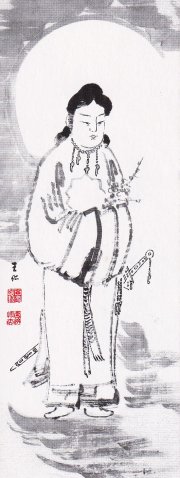 |
|
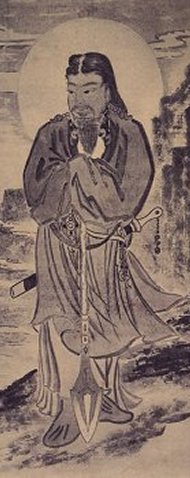 |
| Kamususanowo no Oh Kami (right) working in tandem with Kunitokotachi no Mikoto (left) dubbed "Ushitora no Konjin." |
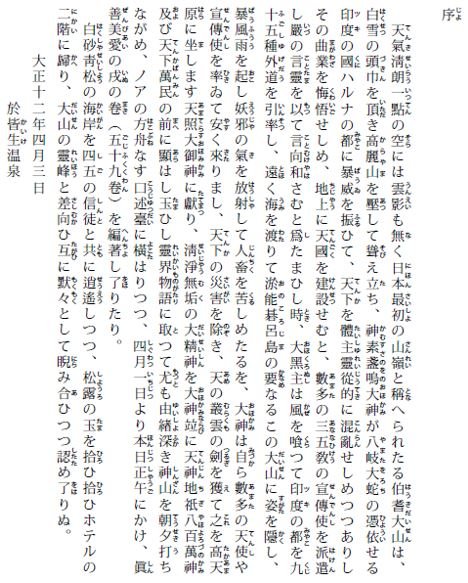 Volume 59, Preface of Reika Monogatari dated April 3, Taisho 12 (1923)
Summary:
- In the age of gods 350,000 years back from today, the Great Black Master possessed by Yamata no Orochi (Eight-Forked Serpent) wreaks havoc on the world from Haruna (present-day Mumbai).
The webmaster's note: The number 350,000 should not be taken literally because it might be a figurative expression.
- To reform the Master and build heaven on earth, the Great Kami Kamususanowo sends out numerous messengers of the Ananai faith to the Indian city.
- Driven out by the righteous deities, the Great Black Master flees all the way to Mount Daisen in Japan, accompanied by his evil retainers, and lurks in the mountain.
For Mount Daisen, see Wikipedia: Mount Daisen
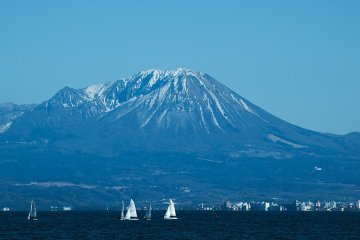 Mount Daisen Mount Daisen (Big Mountain) with a height of 1,729 m above sea level
- The Great Black Master causes violent storms and radiates evil energy to torment locals and native animals.
- The Great Kami Kamususanowo leads his numerous angels and Ananai messengers to Mount Daisen, and destroys the Great Black Master with the Ame no Murakumo no Tsurugi (Heavenly Cloud-Gathering Sword).
- After the showdown, the Great Kami Kamususanowo presents the Ame no Murakumo no Tsurugi Sword to the Goddess Amaterasu Oh Mikami, who dwells in the Taka-ama-hara (Plain of High Heaven), thereby showcasing his great achievement, his integrity, and his commitment to the divine work throughout the world.
While the above is an ancient saga that began in the age of the gods, it will affect the current physical world because, as Onisaburo says, the divine world and the material world are like two mirrors set against each other - namely, what happens in the divine world will happen in the material world, albeit with varying degrees or on different scales.
Over a Third of the Monogatari's Volumes Are Set in India
India appears in the Monogatari as the Tsuki no Kuni (Land of the Moon) and takes up nearly half of its volumes. This suggests the significance of present-day India from a divine perspective.
The following is a list of major settings for individual volumes of the Monogatari:
| Volume |
Setting |
| 1 |
Holy Land of Jerusalem
Note 1: In the age of the gods 350,000 years back from today, Jerusalem was located in Asia Minor, east of Turkey, near the border of Armenia.
Note 2: The number 350,000 should not be taken literally because it might be a figurative expression. |
| 2 |
| 3 |
| 4 |
| 5 |
Mesopotamia, etc. |
| 6 |
Tokoyo no Kuni (Land of Eternity; usually refers to North America), Mesopotamia, etc. |
| 7 |
Tsukushi Jima (Tsukushi Island; present-day African Continent) |
| 8 |
Takasago Jima (Takasago Island; present-day South American Continent) |
| 9 |
| 10 |
Tokoyo no Kuni (present-day United States), Yomotsu Jima (Yomotsu Island; Continent of Mu), etc. |
| 11 |
Present-day Central Asia |
| 12 |
Present-day Egypt, Mediterranean Sea |
| 13 |
Fusa no Kuni (Land of Fusa; present-day Iran) |
| 14 |
| 15 |
| 16 |
Lands of Tamba and Tango on Onokoro Jima (Self-Tumbling Island; present-day Japan) |
| 17 |
| 18 |
| 19 |
| 20 |
| 21 |
Tsu no Kuni (Land of Tsu; southern part of present-day Hyogo Prefecture in Japan) |
| 22 |
| 23 |
| 24 |
Ryugu Jima (Dragon Palace Island; present-day Australian Continent) |
| 25 |
| 26 |
Land of Tamba on Onokoro Jima (present-day Japan) |
| 27 |
Ryukyu (present-day Okinama Islands in Japan) |
| 28 |
Taiwan |
| 29 |
Takasago Jima (present-day South American Continent) |
| 30 |
| 31 |
| 32 |
| 33 |
Land of Tamba on Onokoro Jima (present-day Japan) |
| 34 |
Tsukushi Jima (present-day African Continent) |
| 35 |
| 36 |
Shiro no Kuni (Land of Shiro; present-day Island of Ceylon) |
| 37 |
Autobiographies of Onisaburo Deguchi in present-day Kameoka, Ayabe, etc., Japan |
| 38 |
| 39 |
Fusa no Kuni (present-day Iran) through Tsuki no Kuni (Land of the Moon; present-day India) |
| 40 |
| 41 |
| 42 |
| 43 |
| 44 |
| 45 |
| 46 |
| 47 |
| 48 |
| 49 |
| 50 |
| 51 |
| 52 |
| 53 |
| 54 |
| 55 |
| 56 |
| 57 |
| 58 |
| 59 |
| 60 |
| 61 |
Hymns |
| 62 |
| 63 |
Tsuki no Kuni (present-day India) |
| 64 |
Modern-day Jerusalem |
| 65 |
Tsuki no Kuni (present-day India) |
| 66 |
| 67 |
| 68 |
| 69 |
Land of Uzu (present-day Argentina) on Takasago Jima (present-day South American Continent) |
| 70 |
Tsuki no Kuni (present-day India) |
| 71 |
| 72 |
| Special |
Mongolia (Special Volume: Onisaburo's Mission in Mongolia) |
| 73 |
Primordial universe called Shibi Tenkai (Purple Forbidden Heaven), far way back from the age of the gods - namely, the world immediately after the birth of the universe |
| 74 |
| 75 |
| 76 |
| 77 |
| 78 |
| 79 |
| 80 |
| 81 |
As shown in the yellow areas, India accounts for a large number of the volumes. Volumes 39 through 60 in particular focus on reforming the Middle East. As such, major problems and conflicts are expected to arise in this region as the Kami launches a series of reforms there. The recent conflicts in the Middle East might be a harbinger of the divine work in action.
Volume 39 of the Monogatari indicates that the Great Kami Kamususanowo has decided to leave India on the backburner of his reform agenda, as cited below. This instead has allowed the Great Black Master to do whatever pleases him, bring chaos to the world, and attempt to invade the headquarters of the Ananai faith. However, he is eventually defeated, flees to Mount Daisen, and is destroyed by the Great Kami Kamususanowo on Mount Daisen.
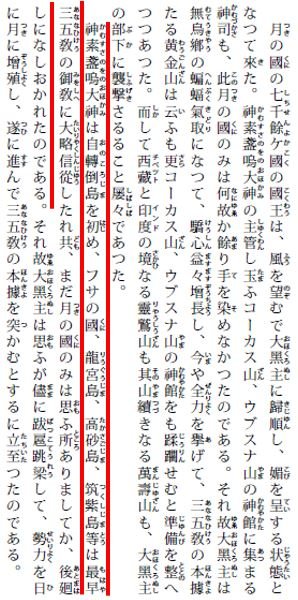 Excerpts from Volume 39 (dictated in Taisho 11, or 1922)
The red line says that the Great Kami Kamususanowo has decided to save India for last on his reform agenda. This implies
that his divine reform will shift to India in the future.
The Great Kami Kamususanowo sends five different kototama squads of Ananai faith messengers on a mission to lead the Great Black Master and his Brahman army into the right path with the power of kototama (divine words). They leave Kamususanowo's Iso Shrine in the Caucasus Mountains to head for Haruna, or present-day Mumbai, and along the way they mend the ways of many local Brahman soldiers (see below).
The kototama squads mentioned above are made up of the following Ananai faith messengers:
| Kototama Squad |
Leader(s) |
Members |
| 1st |
Ohgon-hime, and Kiyoteru-hime |
Kahru, and Rehbu |
| 2nd |
Terukuni-wake |
Teru-koh, Kuni-koh, Ume-koh, Iwa-koh, and Haru-koh |
| 3rd |
Tamakuni-wake |
Michi-koh, Ita-koh, and Sumi-koh |
| 4th |
Harukuni-wake |
Man-koh, Haru-koh, Iso-koh, Matsu-hiko, and Tatsu-koh |
| 5th |
Hatsuwaka-hime |
A spiritual dog dubbed "Smart" |
The Great Black Master possessed by Yamata no Orochi (Eight-Forked Serpent) ends up slain by the Great Kami Kamususanowo with the Ame no Murakumo no Tsurugi (Heavenly Cloud-Gathering Sword) (cf. SECT. XVIII. - THE EIGHT-FORKED SERPENT of the Kojiki)
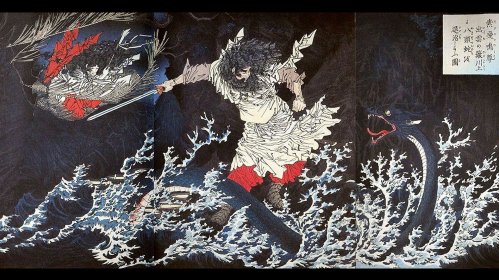 A scene from the Kojiki: Susanowo slaying the evil Serpent. Illustrated by Tsukioka Yoshitoshi
Onisaburo says that this slaying of the Serpent in the age of the gods was a fiasco because its physical body was destroyed while its soul was fragmented and dispersed all over the world, thereby spreading even more evil thoughts than before. There is no point in destroying the physical body unless the spirit dwelling in it can be saved.
As a result, vengeful ghosts dispersing from the slain Serpent in the age of gods have been reborn in today's world and have committed various kinds of offenses again! Learning this lesson, the Great Kami Kamususanowo has resolved not to kill those reborn Serpent fragments but to get them to mend their ways with the power of kototama.
For this reason, it is an important underlying theme of the Monogatari to spiritually reform evil gods or spirits with divine words and guide them back on the right path. Simply killing bad guys won't solve anything fundamentally.
It is interesting to note that Onisaburo dictated tales about the Great Kami Kamususanowo slaying the Great Black Master (Eight-Forked Serpent) on Mount Daisen to his scribes at a Kaike Hot Springs inn in Tottori Province because Kaike of Kaike Hot Springs means to "keep everything alive." In fact, Onisaburo concurred with it, saying that he came to Kaike Hot Springs not to slay anything, but to "keep everything alive." He apparently alluded to the Great Kami Kamususanowo's determination not to make the ancient mistake again.
The Three Major Religions in the Monogatari
The Reikai Monogatari often provides tales related to the three major religions:
- The Ananai faith
- The Brahman faith, and
- The Ural faith
▶The Ananai faith
The Ananai faith (Japanese kanji characters:  ; literally "3 5 faith") is a righteous religion based on the teachings of the Great Kami Kamususanowo, and Kunitokotachi no Mikoto (dubbed "Ushitora no Konjin"). It features reishu taiju (literally "spirit over body" or "flesh subordinated to spirit"; the right balance struck between spiritual and material matters), worship of the Divine, altruism, philanthropy, and promotion of love, goodness, trust and truth. ; literally "3 5 faith") is a righteous religion based on the teachings of the Great Kami Kamususanowo, and Kunitokotachi no Mikoto (dubbed "Ushitora no Konjin"). It features reishu taiju (literally "spirit over body" or "flesh subordinated to spirit"; the right balance struck between spiritual and material matters), worship of the Divine, altruism, philanthropy, and promotion of love, goodness, trust and truth.
 |
|
 |
| Kamususanowo no Oh Kami (right) working in tandem with Kunitokotachi no Mikoto (left) dubbed "Ushitora no Konjin." |
This 3 5 faith was born after the Sandai-kyo (kanji characters:  ; literally "Great 3 faith") and the Godai-kyo (kanji characters: ; literally "Great 3 faith") and the Godai-kyo (kanji characters:  ; literally "Great 5 faith") merged, as described in Volume 6, Chapter 36 of the Reikai Monogatari (dictated on January 22 by the solar calendar, or December 25 by the lunar calender, Taisho 11 (1922)) below: ; literally "Great 5 faith") merged, as described in Volume 6, Chapter 36 of the Reikai Monogatari (dictated on January 22 by the solar calendar, or December 25 by the lunar calender, Taisho 11 (1922)) below:
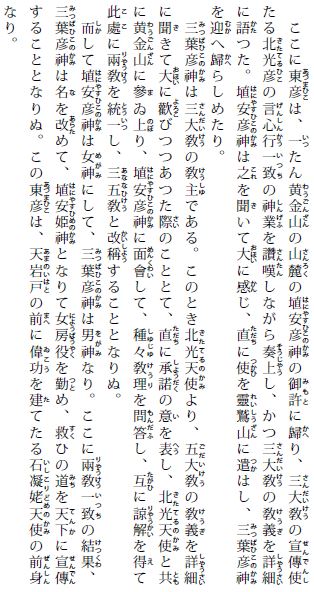 Birth of the Ananai faith (3 5 faith) in Vol. 6 of the Monogatari
Ananai faith believers traverse the globe to propagate the teachings of their faith, spread the gospel of the Kami, and encourage the worship of the Divine. They rely on the power of kototama (divine words) to reform evil gods or spirits and guide them back on the right path. They avoid killing because they know that killing will not solve anything, and that everyone is a living shrine of the Kami and therefore can repent and mend their ways.
Interestingly, many senior Ananai propagandists had committed wrongdoing before they joined the faith. But they have gradually mended their ways, purified themselves and grown spiritually by worshipping the Kami and leading other stray souls back into the right path.
▶The Brahman faith
As mentioned earlier, the Brahman faith in the Monogatari probably has little to do with modern-day Brahmanism because it is defined as any religion that:
- Operates on the principle of "the strong preying on the weak,"
- Controls people through ideology and authoritarianism, and
- Disproportionately puts "power over spirit or body."
With this in mind, let us get a brief overview of the Brahman faith below:
| Brahman faith |
Description |
| Founder |
Oh Kuni-wake (with the aid of his wife Shikokuni-hime)
Webmaster's note:
- Oh Kuni-wake is a child of the Kami Mahesvara Oh Kuni-hiko, a valiant human-shaped kami who descended to the Earth from the planet Uranus.
- The Kami Mahesvara Oh Kuni-hiko was originally an honorable deity residing in the sphere of good gods, but as he settled on the Earth over an extended period of time, he was unconsciously possessed by ghostly vibrations and evil spirits (e.g. evil dragons, foxes and ogres) emanating from the taishu-reiju (carnal pleasure over spiritual purity) evil energy that had filled the Earth since Adaru-hiko (= Adam) and Eba-hime (= Eve) disobeyed heavenly orders. As a result, Oh Kuni-hiko started acting like an evil deity. This further exacerbated the chaos on the Earth like turbid water, with foul and filthy energy permeating the planet.
- Driven out by righteous deities, Ural-hiko (founder of the Ural faith) and his wife Ural-hime fled to the Tokoyo no Kuni (Land of Eternity; usually corresponds to modern-day North America), where they ordered Oh Kuni-wake and his wife Shikokuni-hime to found the Brahman faith - a second Ural faith, as it were - in the Egyptian City of Iho. Accordingly, Oh Kuni-wake and Shikokuni-hime founded the faith in the Egyptian city.
|
| Headquarters |
The City of Iho in Egypt, initially
Webmaster's note:
- The headquarters of the Brahman faith has been relocated to:
- The Mesopotamia
- Mount Oe in Japan, and
- The City of Haruna (modern-day Mumbai) in India
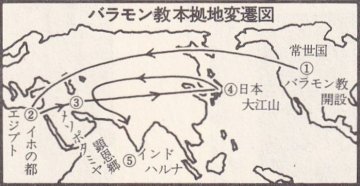 Changes in Brahman faith headquarters
1. Land of Eternity (North America), where Ural-hiko and Ural-hime ordered Oh Kuni-wake and Shikokuni-hime to found the Brahman faith
2. Egyptian City of Iho
3. Mesopotamia
4. Mount Oe in Japan, and
5. Indian City of Haruna (Mumbai)
- The changes in Brahman faith headquarters may have a significant geopolitical impact on the future state of the world in light of the kata (model) principles.
|
Grand Master
(= head of the Brahman faith) |
Onikumo-hiko (literally, "Prince Ogre Cloud")
Also known as the Oh Kuro Nushi (Great Black Master)
When Oh Kuni-wake, founder of the Brahman faith, passed away, his son Oh Kuniwake-hiko, who was also the sole legitimate heir to the Brahman throne, was ousted by Onikumo-hiko, one of Oh Kuni-wake's top aides, as he had an ulterior motive for power and prestige. Since then he had called himself "Oh kuni-hiko" or the "Deity Great Black Master."
The Great Black Master kissed his lawful wife Onikumo-hime off, took Isono-hime, a young and beautiful deity, as his new wife, had many concubines serve him, and dwelt in a cavern in the middle of Mount Taiun near the City of Haruna (modern-day Mumbai).
The Great Black Master proclaimed to come from the authentic mainstream kshatriya, thereby arguing that he was qualified to be grand head of the whole Land of the Moon (Lunar Dynasty). As a result, kings of some 7,000 smaller kingdoms within the Land of the Moon swore allegiance to and even curried favor with the Great Black Master.
The Brahman faith under Oh Kuni-wake remained a small religious group, whereas the Great Black Master played a significant role in laying the foundations for the faith and transforming it into a global phenomenon - in a negative way.
The Brahman faith as described in the Monogatari was founded in the age of gods some 300,000 years before the birth of Siddhartha Gautama.
|
| Teachings |
The Brahman faith teaches that asceticism pleases the will of the Divine. It misinterprets the true meaning of the reishu taiju (right balance between spirit and body, with spirit always prioritized over body), disregards the flesh, and overemphasizes spirits and souls.
Believers of this faith go stark naked and jump into thorns, walk through fire, dive in water, go stark naked in the coldest season or walk barefoot across rugged mountains.
As entry-level ascetic practices, Brahman believers wear shoes whose soles are studded all over with nails. Their feet bleed when they walk in those shoes.
Therefore, believers of the Brahman faith have their whole bodies bleeding and festering. This is nothing less than a ghastly sight. The Brahman faith takes pride in mortifying the flesh.
Evil spirits, such as Yatsugashira Yatsuo (Eight-headed, eight-tailed serpent), Kimmoh-kyubi Hakumen no Akko (White-faced evil fox with nine blonde tails), and demons, like to see human blood so much that they tend to possess those Brahman believers who mortify their own flesh under the pretext of the reishu taiju (right balance between spirit and body, with spirit always prioritized over body) as they misinterpret the true meaning of this spiritual precept.
Generally, believers of the Brahman faith make light of life, attach importance to death, and look forward to nothing but being saved in heaven where they can bask in absolute, infinite glory and bliss. (NB: Given the precept of the reishu taiju, it is a gross violation of the Great Way of the Kami to make light of the human body as a living shrine of the Divine. In other words, body is just as important as spirit.)
Good deities fear that a wider spread of the Brahman faith can lead to a total extinction of living creatures on earth.
The Brahman faith classifies human souls into three distinct categories: upper, medium and lower levels. People born from the head of the Kami Mahesvara Oh Kuni-hiko and their descendants invariably belong to the upper-level category, assume high-ranking posts, and become rulers no matter how foolish or benighted they may be. People born from the abdomen of the Kami Mahesvara Oh Kuni-hiko and their descendants stand between high- and low-ranking people, become quasi-rulers, and lead an easy life. The remaining masses born from the legs of the Kami Mahesvara Oh Kuni-hiko and their descendants lead a life of toil and sweat and are exploited by the ruling classes. They are also forced to practice asceticism, so they become emaciated or succumb to death.
Angry outcries have been mounting in areas that practice the Brahman faith as many locals have been subjected to a hellish life. Meanwhile, evil deities have been gaining greater traction, with their sphere of influence spreading to the Land of Fusa (modern-day Iran) and then to the Land of the Moon (modern-day India).
|
For your reference, the following is the source of some of the details above (excerpts from Volume 15 of the Monogatari dictated on March 31, 1922):
▶The Ural faith
The Ural faith is a taishu reiju (spirit subordinated to flesh; material gratification prioritized over spiritual growth) religion founded by Ural-hiko.
The Ural faith was formerly called the Daichu-kyo (Japanese kanji characters:  ; literally "egocentric faith") as dai of daichu can be taken apart to mean "egocentric" while chu means "center": ; literally "egocentric faith") as dai of daichu can be taken apart to mean "egocentric" while chu means "center":
Originally, the "one person" referred to the Great Kami Pangu (= Ural-hiko), who the Daichu-kyo claimed was the ultimate Kami of this world, the sole king, and the greatest authority. Therefore, this faith initially taught that adherents must believe in nothing but this one and only Pangu and obey all of His orders. As time passed, however, many Daichu-kyo missionaries distorted the founding philosophy of the religion and misinterpreted egocentrism as the central tenet of the Daichu-kyo. Their misinterpretation was heavily influenced by evil vipers, foxes and ghosts that possessed them.
Here the Great Kami Pangu was NOT the original Pangu. It was actually Ural-hiko, who proclaimed himself Pangu to take advantage of his authority.
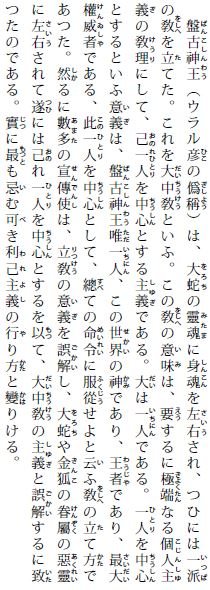 Description of Ural faith (Excerpts from Vol. 6 of Monogatari)
| Ural faith |
Description |
| Founder |
Ural-hiko, who proclaimed himself the Great Kami Pangu.
Webmaster's note:
- Here the Great Kami Pangu is NOT the original Pangu but an imposter. It is actually Ural-hiko who pretends to be Pangu.
- The true Great Kami Pangu is described in Vol. 2 of the Reikai Monogatari as follows:
The Great Kami Pangu Shionaga-hiko, a direct descendant of the Great Sun God, is a human-shaped deity who descended to the Earth from the Solar Kingdom. The Great Sun God, i.e the Kami Izanagi no Mikoto, was caught off guard so much that he let Shionaga-hiko slip through his fingers and descend to what is now a northern part of China. He is a mild-mannered righteous kami.
- The Great Kami Pangu worshipped in the Ural faith is the same as Ural-hiko, who proclaimed himself the Great Kami Pangu. Therefore, the Ural faith is a personality cult for Ural-hiko.
|
| Founded in |
Armenia
The main operation bases of the Ural faith were:
- The Ural Mountains
- Armenia, and
- The Caucasus Mountains
The Ural faith has been headquarted on the Rocky Mountains in the Tokoyo no Kuni (Land of Eternity; modern-day North America) since Ural faith members fled from conflicts with Ananai and/or Brahman faith believers.
Locations of the Ural faith bases and headquarters may have a significant geopolitical impact on the future state of the world in light of the kata (model) principles.
|
| Former name |
The Daichu-kyo, which has later been called the "Ural faith." |
| Head of the Ural faith |
Ural-hiko (= Tokoyo-hiko, Jr.)
Webmaster's note:
-
Ural-hiko's former name was Tokoyo-hiko, Jr. As 7th Chief Angel, he was the principal culprit in the ouster of Kunitokotachi no Mikoto, the creator and supreme ruler of the Earth's divine world.
- Tokoyo-hiko, Sr. was a kami born from the iki (water and fire = breath) of the Great Kami Pangu and served him as one of his top aides.
-
Tokoyo-hiko, Jr. was also a top aide to the Great Kami Pangu. As time passed, however, he expelled his master and became Pangu himself.
- Tokoyo-hiko, Jr. renamed himself "Ural-hiko" to avoid confusion with the Tokoyo Shinnoh (Divine King of the Tokoyo no Kuni), the self-proclaimed title of Oh Kuni-hiko, the founder of the Brahman faith.
|
| Teachings |
The Ural faith teaches the importance of taishu reiju (spirit subordinated to flesh; material gratification prioritized over spiritual growth).
The Ural and Brahman faiths are "sibling religions" because evil spirits controlling Ural-hiko and his wife Ural-hime posessed Oh Kuni-wake and made him found the Brahman faith in the Egyptian City of Iho. Therefore, the Brahman faith, basing its doctrine on the Ural faith, is dubbed the "second Ural faith."
The basic chant for Ural missionary work goes like this:
Drink and make merry.
For no one knows what the future holds.
Out of darkness comes the Moon.
The Ural faith denies mysticism and focuses on science.
The Ural faith is atheistic.
The Ural faith centers on intellect, whereas the Brahman and Ananai faiths center on rationality and emotions, respectively.
Ural-hime, the wife of Ural-hiko, calls herself Ogetsu-hime, builds grand palaces and manor houses on the Caucasus Mountains, and lives in luxury with her retainers. This is a typical feature of the way Ural faith believers lead a taishu-reiju, extravagant life by indulging in gorgeous food, clothing and shelter.
Incidentally, Ogetsu-hime appears in the following section of the Kojiki as the Deity Princess-of-Great-Food, although the two might not be the same kami:
The Kojiki: Sect. XVII. - The August Expulsion of His-Impetuous-Male-Augustness.]
|
As shown above, the Ananai faith, the Brahman faith, and the Ural faith constitute the three major religions in the Reikai Monogatari.
The Monogatari often depics scenes where believers of the reishu-taiju Ananai faith strive to reform believers of the reishu-taiju (or ryokushu-tairei) Brahman faith and the taishu-reiju Ural faith with non-violence and divine kototama words/teachings.
To recap what has been stated above, please refer to the following table:
Great Kami Kamususanowo vs. Yamata no Orochi
Protagonist /
Antagonist in
Monogatari |
Kamususanowo
(Saviour Deity) |
Yamata no Orochi (Satan) |
| Type of Religion |
Ananai faith |
Brahman faith |
Ural faith |
| Ideological Principles |
• Reishu taiju (flesh subordinated to spirit; spirit over body)
• Worship of the Divine and altruism
|
• Ryokushu tairei (power overrides flesh or spirit; power over flesh/spirit)
• The stronger preying upon the weaker is right. |
• Taishu reiju (spirit subordinated to flesh; body over spirit)
• Egotism |
| Tone of Language |
Kototama of love and goodness; words in 31-syllable
poems |
Imperative ("You must ...") |
Assertive |
| Deity Worshipped |
Deity of regeneration with the Maitreyan Consciousness
(i.e. utmost philanthropy and benevolence) |
Deity that forces submission |
Deity as part of laws of nature |
| Society |
One of love and goodness where the entire human race peacefully coexists |
One ruled by power - notably, political, military, economic, academic and physical power |
One dominated by elements of rationality, such as laws and regulations, doctrines, science and technology, and productivity |
| Time Orientation |
Expansion of space (conceptual realm) that contributes to the formation and development of heaven on earth |
Linear progression that fosters a vicious
infinity of power and material pursuits; it is nihilistic and never makes society self-sufficient. |
Linear progression that fosters a vicious
infinity of power and material pursuits; it is nihilistic and never makes society self-sufficient. (Same as Brahman faith) |
| Relationship to Humanity |
Liberator → joy and happiness → symbiosis and creation |
Master-servant relationship → the discriminating vs. the discriminated, and command vs. submission → callous indifference → loneliness and nihilism |
Self-complacent absolutization → disharmony, egotism and conspiracy → callous indifference → loneliness and nihilism |
Important events in the Monogatari that describe major confrontations between the Great Kami Kamususanowo and the Great Black Master
Let us now focus on Monogatari stories that relate to major confrontations between the Great Kami Kamususanowo and the Great Black Master. That is because those divine reforms will likely unfold in the material world sooner or later if the Monogatari is a book of prophecies as it is claimed to be by Onisaburo Deguchi.
▶Volume 39
Volume 39 in particular is noteworthy in that Kamususanowo launches a campaign to reform the Great Black Master with kototama (divine words) on a full scale by sending five different kototama squads of Ananai faith messengers on a mission to Haruna (present-day Mumbai), where the Brahman faith is headquartered, from the Caucasus Mountains (see below).
The kototama squads mentioned above are made up of the following Ananai faith messengers:
| Kototama Squad |
Leader(s) |
Members |
| 1st |
Ohgon-hime, and Kiyoteru-hime |
Kahru, and Rehbu |
| 2nd |
Terukuni-wake |
Teru-koh, Kuni-koh, Ume-koh, Iwa-koh, and Haru-koh |
| 3rd |
Tamakuni-wake |
Michi-koh, Ita-koh, and Sumi-koh |
| 4th |
Harukuni-wake |
Man-koh, Haru-koh, Iso-koh, Matsu-hiko, and Tatsu-koh |
| 5th |
Hatsuwaka-hime |
A spiritual dog dubbed "Smart" |
Are you aware that the Russo-Ukrainian War, conflicts in Central Asia, mounting tensions in the Middle East (especially Iran), the emergence of India as a powerful nation, and other similar events seem to be trailing the kototama squads, who walk the path from the Caucasus Mountains to Mumbai to reform the Great Black Master?
If current affairs are related to the storyline of the Monogatari, India will likely undergo major social, political or economic changes/reforms in the future, and they will affect Japan to an alarming extent.
For your reference, the following is a list of major settings for Volumes 39 through 60 of the Monogatari. As you can see, Iran and India dominate the volumes.
| Volume |
Setting |
| 39 |
Fusa no Kuni (present-day Iran) through Tsuki no Kuni (Land of the Moon; present-day India) |
| 40 |
| 41 |
| 42 |
| 43 |
| 44 |
| 45 |
| 46 |
| 47 |
| 48 |
| 49 |
| 50 |
| 51 |
| 52 |
| 53 |
| 54 |
| 55 |
| 56 |
| 57 |
| 58 |
| 59 |
| 60 |
Kamususanowo's campaign to reform the Great Black Master begins with the dispatch of the First Kototama Squad, i.e. Ohgon-hime and her daughter Kiyoteru-hime.
While going down on the steep slope, Ohgon-hime and Kiyoteru-hime encounter five Brahaman faith soldiers named Eeru, Joseph, Hamu, Taru, and Rehbu. They try to capture the two women, so they throw Eeru, Joseph and Hamu into the nearby valley. Scared, Taru and Rehbu run away from the scene.
Of the three thrown into the valley, the fainted Eeru and Joseph rove the Spirit World, where Ohgon-hime and Kiyoteru-hime appear as goddesses and take the Brahman faith soldiers to the Deity Tsukiteru-hiko no Mikoto's splendid palace. They walk through to the back of the palace and see a swamp there. Before they know it, they find themselves sinking into the swamp, with Ohgon-hime, Kiyoteru-hime and the beautiful palace vanishing without a trace.
Eeru and Joseph come to the base of a pine tree. They take a good at it and discover a human neck extending out of the soil, with a monster serpent hovering over it. They are stunned to identify the human neck as the Great Black Master, the Grand Master Builder of the Brahman faith. (See excerpts below)
The Great Black Master says that he has received a divine punishment and has been buried under the soil. He goes on to encourage Eeru and Joseph to repent their sins and get back on the right path.
Then the two Brahman soldiers begin to hear the Basic Missionary Chant of the Ananai faith. When they come awake, they find themselves being treated by Terukuni-wake and other Ananai faith messengers at the bottom of the valley.
While the vice guardian deity of the Great Black Master has wreaked havoc on the global stage in the physical world, his main guardian deity in the Spirit World has already been severely punished by the Kami.
The webmaster's note:
Onisaburo teaches that each person is under the protection of a main guardian deity and a vice guardian deity.
The main guardian deity is a spiritual fragment of the Kami and acts as a spiritual guide.
The vice guardian deity, meanwhile, controls the person's physical functions, tends to pursue carnal desires, and often conflicts with the main guardian deity for overall governance of the person.
Reishu taiju (literally "spirit over body" or "flesh subordinated to spirit"; the right balance struck between spiritual and material matters) is the state where the main guardian deity dominates the person.
By contrast, taishu reiju (literally "body over spirit" or "spirit subordinated to flesh"; material gratification prioritized over spiritual growth) is the state where the vice guardian deity dominates the person.
For this reason, Onisaburo encourages us to make our vice guardian deities repent and align with the spiritual guidance of our main guardian deities through constast exposure to the Divine, holy scriptures or daily/monthly prayer services.
Excerpts from Vol. 39, Chap. 7 on the miserable future of the Great Black Master
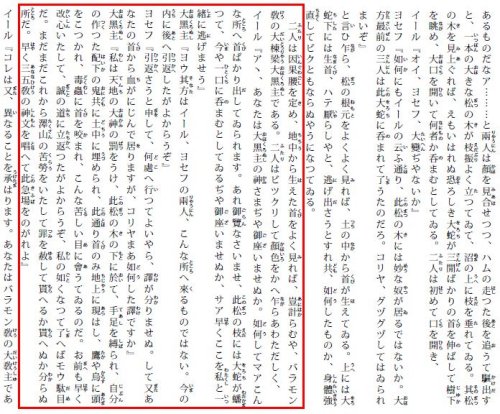 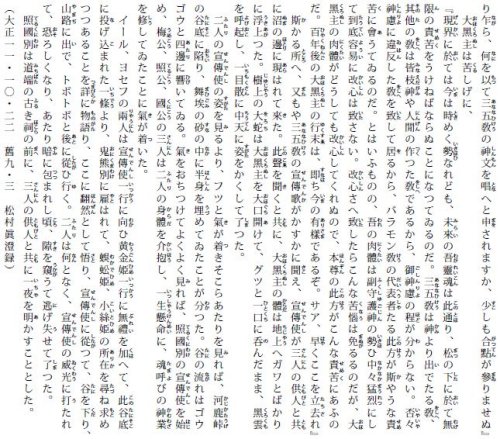
It is safe to think that the Great Black Master symbolizes any individual or organization that thinks or acts like the Great Black Master. In this respect, many individuals or organizations - regardless of nationality, race, religion or gender - probably think or act like the Great Black Master, hence his pawns.
Onisaburo implies that many Japanese people in his days thought and acted like Brahman believers, straying from the right divine path.
Some chapters of the Monogatari describe Brahman believers as holding swords in their right hands and the Quran in their left hands.
Therefere, any religion that fits the description of Brahmanism in the Monogatari can be Brahmanistic, and any person that upholds Brahmanistic principles can be a Brahman believer.
As shown in the map below, the five kototama squads reform Brahman believers with kototama in the pale blue area between the Iso Shrine (Ananai faith sanctuary) at the foot of the Caucasus Mountains and the Indian City of Haruna (Mumbai). Please note that this area includes modern-day Iran, Afghanistan, Pakistan and India.
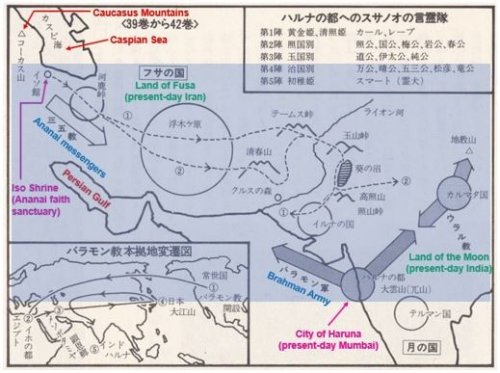 Map of Great Kami Kamususanowo vs. Great Black Master By courtesy of Hachiman ShotenDivine Ananai propagandists are dispached to Mumbai to bring the Great Black Master to his knees.
Those kototama squads appear in the following volumes of the Reikai Monogatari:
| Kototama Squad |
Leader(s) |
Volumes |
| 1st |
Ohgon-hime, and Kiyoteru-hime |
Vol. 39 - 42 |
| 2nd |
Terukuni-wake |
39 - 40, 66 - 72 |
| 3rd |
Tamakuni-wake |
43 - 44, 49, 56 - 60, 63, 65 |
| 4th |
Harukuni-wake |
43 - 48, 53 - 55 |
| 5th |
Hatsuwaka-hime |
49 - 52, 58 - 59, 63, 65 |
▶Volume 40
The preface of this volume says that Oh Yashima-hiko no Mikoto, a heroic kami in the age of gods, was reincarnated as Tsukiteru-hiko no Mikoto, and that Tsukiteru-hiko no Mikoto was finally born again in India as Siddhartha Gautama, or most commonly known as the Buddha.
In the General Remarks section, Onisaburo first summarizes the four major social classes in the Indian caste system: the Kshatriyas, the Brahmins, the Vaishyas, and the Shudras. He then gives profound insights into Brahmanism from the perfective of the Reikai Monogatari.
Specifically, Onisaburo describes how Brahmanism - probably a precursor of today's Brahmanism - was founded in the age of gods as follows:
- Mahesvara was Oh Kuni-hiko no Mikoto. He was born in the Tokoyo no Kuni (Land of Eternity), or modern-day North America. He proclaimed himself Tokoyo Shinnoh (divine king of the Land of Eternity)
- Oh Kuni-wake no Mikoto, the son of Oh Kuni-hiko no Mikoto, founded the Brahman faith.
- The headquarters of the Brahman faith has been relocated from the Tokoyo no Kuni (modern-day North America) to:
- Egypt
- Mesopotamia, and
- Indian City of Haruna (present-day Mumbai) after crossing Persia
The basic foundations of the Brahman faith have been laid and solidified since Onikumo-hiko, deputy kami of the founder Oh Kuni-wake no Mikoto, emerged as the Great Black Master. The Brahman faith before then had only a small following. This Brahman faith dates back to a distant age of gods in which Susanowo no Mikoto reigned as a heroic kami, i.e. some 300,000 years prior to the birth of Siddhartha Gautama.
Chapter 1 provides some details of the Great Black Master:
- Onikumo-hiko (literally, "Prince Ogre Cloud") relocated the headquarters of the Brahman faith to the cavern of Tai-un zan (literally, "Mount Great Cloud") in the City of Haruna after having ousted Kuniwake-hiko, the son of Oh Kuni-hiko no Mikoto (= Mahesvara) and also the sole legitimate heir to the Brahman throne).
- Onikumo-hiko falsely proclaimed himself a direct descendant of Brahma and subjugated most Kshatriyas in 7,000 strong kingdoms within the Land of the Moon (modern-day India).
- A Ural-faith kingdom called Karumata emerged on the Deccan plateau, and Tokoyami-hiko, a Ural-faith propagandist, and his members attacked the Brahman faith while holding the Koran in their left hands and swords in their right hands. This seriously undermined the foundations of the Brahman faith.
- The Brahman faith was also threatened by the rapid expansion of the Ananai faith under the leadership of the Kami Kamususanowo.
- Against this backdrop, the Great Black Master held an executive meeting in which he directed his top aides to formulate strategies to counter the Ananai and Ural faiths.
- Oniharu-wake was appointed to conquer the Ananai faith headquarters at the Iso Shrine in the Land of Fusa (modern-day Iran). Likewise, Ohdaru-wake was appointed to attack the Ural-faith Kingdom of Karumata. This is why the five kototama squads of Ananai messengers often engaged with Brahman faith believers and in most cases successfully reformed them with kototama divine words.
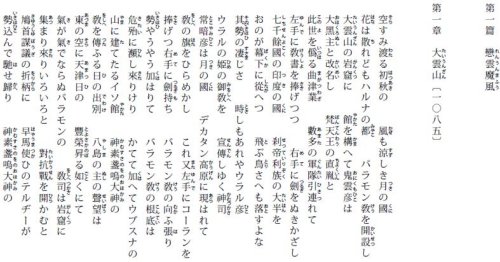 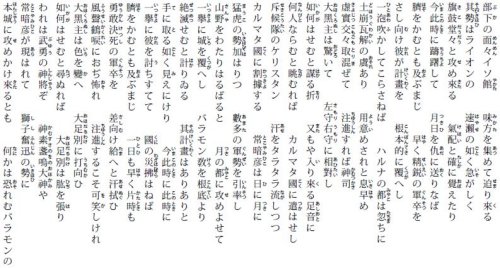 Details of the Great Black Master in Volume 40, Chapter 1 of the Monogatari

Onisaburo in Omoto missionary robe and headgear |
|
| |
